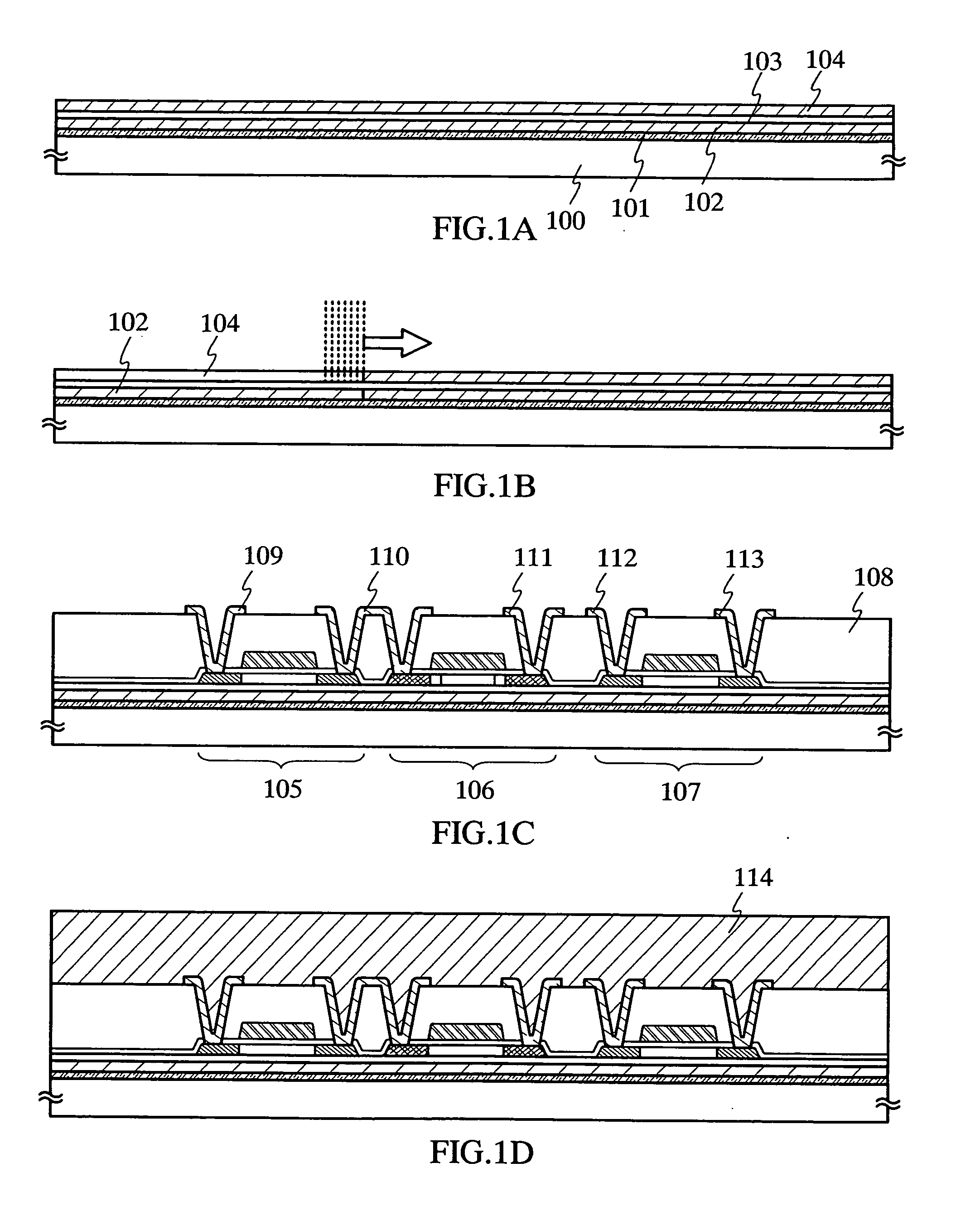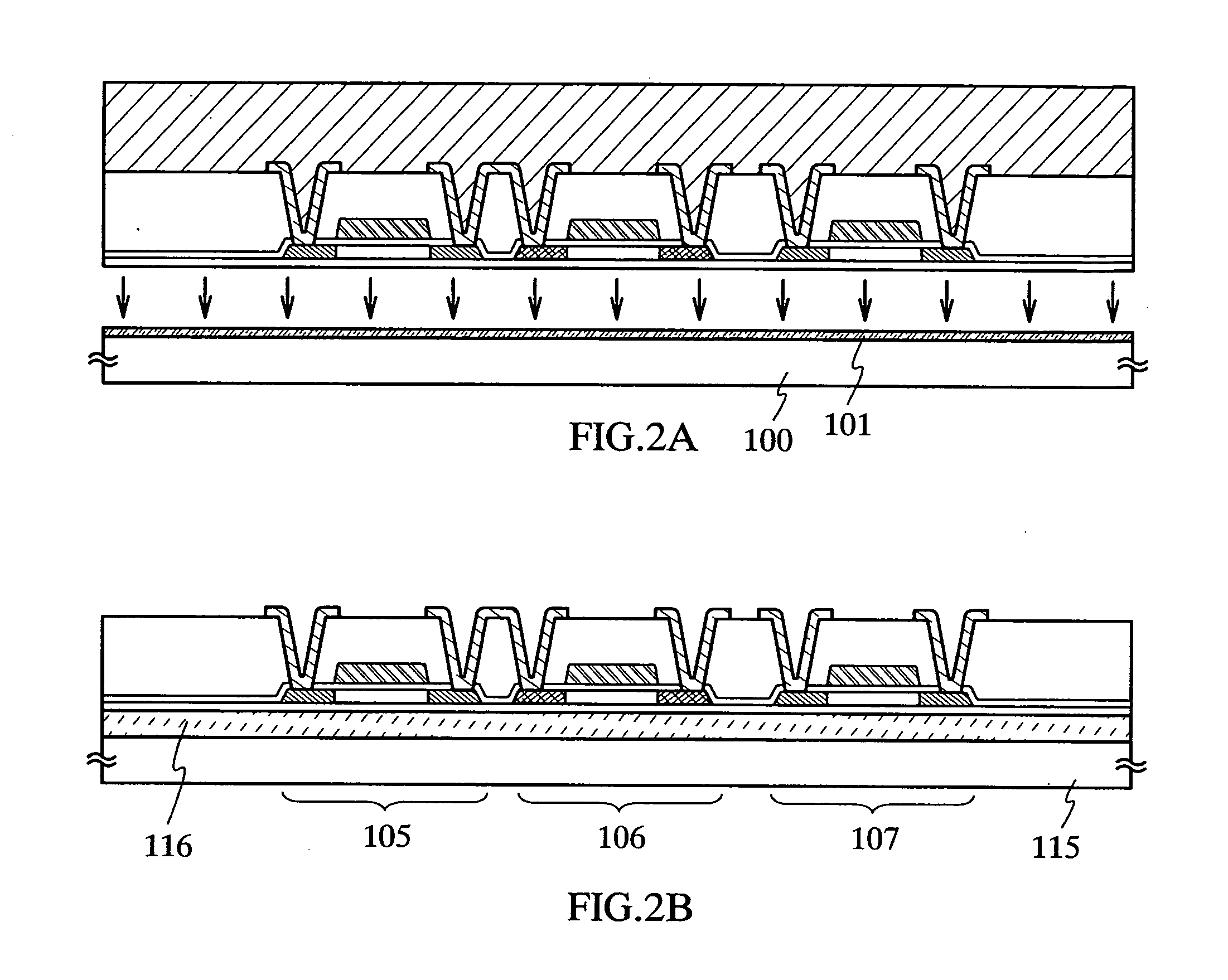Method for manufacturing semiconductor device
a manufacturing method and semiconductor technology, applied in the direction of semiconductor devices, basic electric elements, electrical equipment, etc., can solve the problems of difficult to continue manufacturing semiconductor elements, peeling layers tend to be peeled from the substrate, and flexible substrates such as plastic substrates may not have such high heat resistance, so as to achieve the effect of rapidly peeling semiconductor elements
- Summary
- Abstract
- Description
- Claims
- Application Information
AI Technical Summary
Benefits of technology
Problems solved by technology
Method used
Image
Examples
embodiment 1
[Embodiment 1]
[0057] Next, this embodiment describes a detailed method for manufacturing an ID chip which is one of semiconductor devices employing a manufacturing method of the present invention. Note that this embodiment shows an insulated TFT as an example of semiconductor elements; however, a semiconductor element used for an integrated circuit is not limited thereto and all circuit elements can be used.
[0058] First, as shown in FIG. 3A, a buffer film 501 is formed on a heat-resistant first substrate 500. For example, a glass substrate such as a barium borosilicate glass or an alumino borosilicate glass, a quartz substrate, a ceramic substrate, or the like can be used for the first substrate 500. Alternatively, a metal substrate including a stainless substrate or a semiconductor substrate may also be used. Although a substrate made of flexible synthetic resin such as plastics generally tends to be inferior in heat-resistant temperature as compared with the above substrates, the...
embodiment 2
[Embodiment 2]
[0134] This embodiment describes an optical micrograph of the sample in which a peeling layer is etched after crystallizing it by performing laser crystallization of a semiconductor film with a continuous-wave laser.
[0135] The sample used in this embodiment is formed by sequentially laminating a buffer film, a peeling layer, a base film, and a semiconductor film over a glass substrate; then crystallizing the semiconductor film by using a catalyst element; further the semiconductor film is partially crystallized with a continuous-wave laser; and then the crystallized semiconductor film is removed by etching. Then, a groove is formed by scribing, and thus, the peeling layer is exposed and etched partially.
[0136] Specifically, the buffer film made of 100 nm thick silicon oxynitride is formed over a glass substrate by using a sputtering method, and the peeling layer made of 50 nm amorphous silicon is formed over the buffer film by using a plasma CVD method to form each s...
embodiment 3
[Embodiment 3]
[0141] A structure of an ID chip in the case of forming a wiring and an antenna connected to a TFT concurrently by patterning a conductive film is described with reference to FIG. 12A. FIG. 12A shows a cross-sectional view of the ID chip in this embodiment.
[0142] In FIG. 12A, a TFT 1401 includes an island-shape semiconductor film 1402, a gate insulating film 1403 being in contact with the island-shape semiconductor film 1402, and a gate electrode 1404 overlapped with the island-shape semiconductor film 1402 by sandwiching the gate insulating film 1403 therebetween. In addition, the TFT 1401 is covered with a first interlayer insulating film 1405 and a second interlayer insulating film 1406. Note that the TFT 1401 is covered with the two interlayer insulating films of the first interlayer insulating film 1405 and the second interlayer insulating film 1406 in this embodiment; however, this embodiment is not limited to this structure. The TFT 1401 may be covered with a s...
PUM
 Login to View More
Login to View More Abstract
Description
Claims
Application Information
 Login to View More
Login to View More - R&D
- Intellectual Property
- Life Sciences
- Materials
- Tech Scout
- Unparalleled Data Quality
- Higher Quality Content
- 60% Fewer Hallucinations
Browse by: Latest US Patents, China's latest patents, Technical Efficacy Thesaurus, Application Domain, Technology Topic, Popular Technical Reports.
© 2025 PatSnap. All rights reserved.Legal|Privacy policy|Modern Slavery Act Transparency Statement|Sitemap|About US| Contact US: help@patsnap.com



